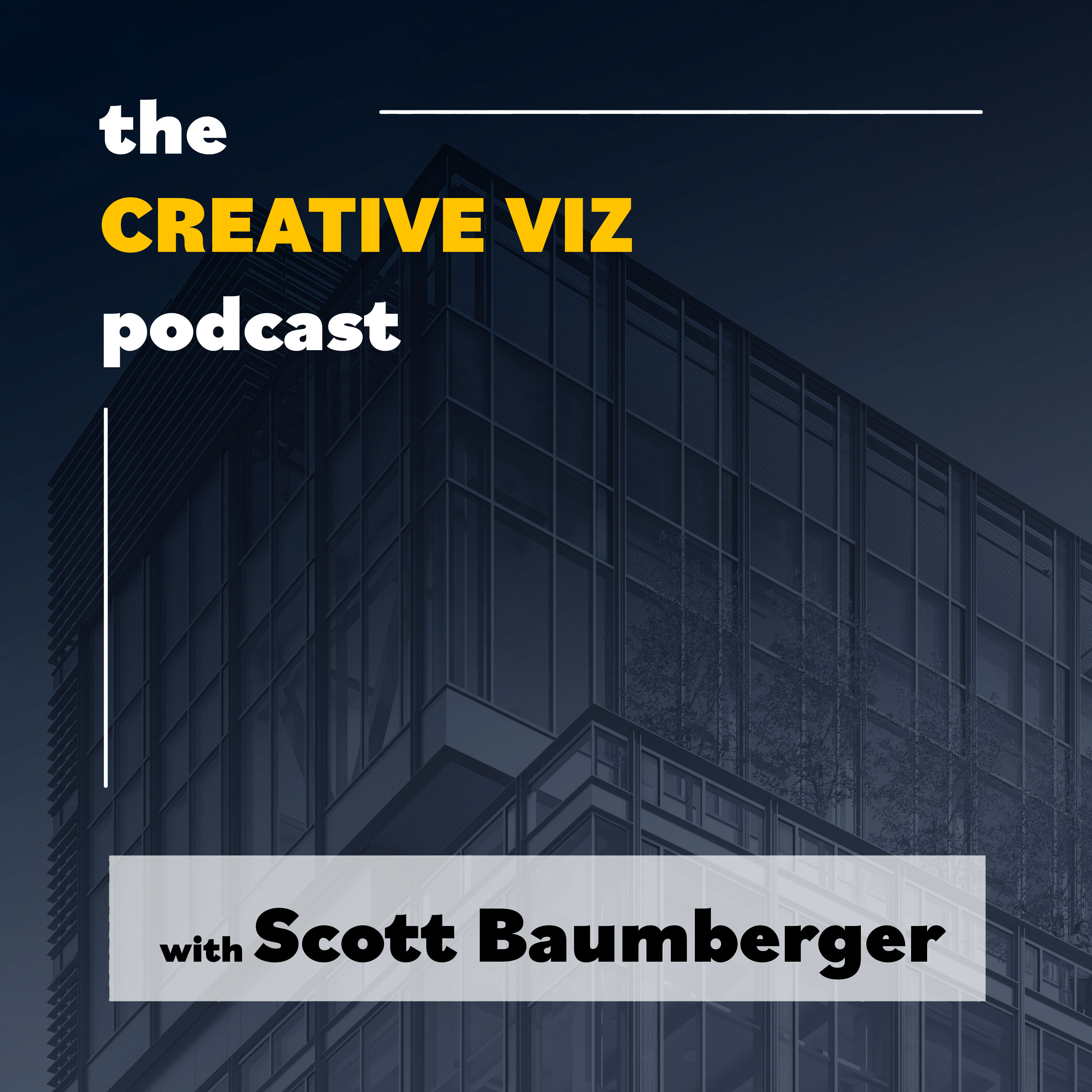

Building Bridges: Communication Strategies for Seamless Archviz Collaborations
The Creative "Viz"
| Scott Baumberger | Rating 0 (0) (0) |
| www.apex-visualization.com | Launched: Oct 07, 2023 |
| scott@apex-visualization.com | Season: 1 Episode: 2 |
Welcome to the "Creative Viz" podcast, where architecture, development, and visual design converge. In this insightful episode, we unravel the critical element that can make or break any creative venture: effective communication between artists and clients. Join us as we explore the world of architectural visualization (archviz) and dissect the essential strategies that ensure seamless collaboration.
Discover the key takeaways:
- Establishing a rock-solid foundation by defining project scope, schedules, and objectives.
- Crafting clear goals and success criteria, adapting them to different project phases.
- The artist's art of active listening, uncovering potential challenges, and ensuring client satisfaction.
- Delving into the details of project location, considering landmarks, vegetation, and atmospheric conditions.
- Navigating the client's role in sticking to schedules, providing clarifications, and offering timely feedback.
- The power of asking questions to maintain transparency and avoid costly misunderstandings.
- Implementing foolproof checklists to prevent project oversights, especially in complex ArchViz endeavors.
Don't miss this episode if you're in the world of architecture, design, or simply seeking insights into effective communication strategies for creative projects. It's your roadmap to building success through clarity and collaboration.
SUBSCRIBE
Episode Chapters

Welcome to the "Creative Viz" podcast, where architecture, development, and visual design converge. In this insightful episode, we unravel the critical element that can make or break any creative venture: effective communication between artists and clients. Join us as we explore the world of architectural visualization (archviz) and dissect the essential strategies that ensure seamless collaboration.
Discover the key takeaways:
- Establishing a rock-solid foundation by defining project scope, schedules, and objectives.
- Crafting clear goals and success criteria, adapting them to different project phases.
- The artist's art of active listening, uncovering potential challenges, and ensuring client satisfaction.
- Delving into the details of project location, considering landmarks, vegetation, and atmospheric conditions.
- Navigating the client's role in sticking to schedules, providing clarifications, and offering timely feedback.
- The power of asking questions to maintain transparency and avoid costly misunderstandings.
- Implementing foolproof checklists to prevent project oversights, especially in complex ArchViz endeavors.
Don't miss this episode if you're in the world of architecture, design, or simply seeking insights into effective communication strategies for creative projects. It's your roadmap to building success through clarity and collaboration.
Hello, and welcome to the creative is podcast, where we dive into topics related to architecture, development, and visual design.
In today's episode, we're going to investigate a critical element to the success of any creative endeavor. That is communication between the artist and the client.
Within our podcast, we're going to be focusing on archviz And today we're going to be looking at what communication should be, or could be, between artist and client for a typical archviz project. Clear communication is important throughout. But there are specific things that both parties can do to ensure things go as smoothly as possible.
At the outset, they should each have a clear understanding of the scope, the schedule of of the project. It's important to document this as thoroughly as possible up front. It's going to eliminate any misunderstandings down the road. Both the client and artist should have a clear sense of why the visuals are being, Commissioned. What are the goals? What are, who is the audience for the visuals? And more importantly, what does success look like?
This is going to be really different for early phase visuals versus later phase design development review and late phase visuals when we're at a point where we might be selling or leasing the building. Audiences can be very different. Success is going to look really differently. It's very important to identify this upfront and have both parties on board. For the artists, it's especially important to actively listen to the client at this stage as specifically as possible. There may be significant history to the project. There may be landmines that the audience is going to be sensitive to. There may be things they've run into that have created significant problems for them in the past. And it's important for the artist to know about these up front, ask if there are any that the client may not even be aware of and identify these before production begins so we're not wasting any time.
And then here are a few other things that the artist should be thinking about as the project moves forward through the rendering and visual workflow. It's really important for the artists to have a thorough understanding of what the current phase of the development project is. If you're creating visuals for competition that's a very different situation, very different set of visuals than for marketing and sales. It's really important for the artist to research the project location thoroughly understand the specifics of the site. Are there going to be any landmarks that might be visible in the visuals? What are local trees vegetation, what do they look like? And this one might not be as obvious, but what does the sky look like in this location? So, I think about a project in Florida. Obviously, the trees are going to be very different than, say, Colorado or Illinois but also the sky. It's going to have a different quality through different times of day, different times of the year. So it's really important to soak in as much of the the specifics of the site, really understand what it's about what the story of the site is going to be, because that will inform a lot of the creative decisions as you move forward, from an artist's perspective to clearly explain the rendering workflow to the client that is when should they expect reviews and what it's about. Is each review going to be about it can help to go ahead and schedule these specific dates.
Well, it's not always necessary, but what is important is for the client to understand how many points of review they can have how much influence they can have and reviewing and marking up in progress images as things develop. It's important to do that up front. And then once get to each review point the artist should explain with the draft that they're, are reviewing what. They have locked down and what items might still be in play. So, for instance there are early reviews, you may be just focusing on mood and lighting and later on, you're going to be More focused on the camera positions once are locked down and decided upon, then you can work on entourage and some of the finishing elements. So it's important to do that in a very linear fashion. And it's the artist responsibility to clearly share with the client, what phase of their workflow they're in and what items they should be focusing on the other thing that the artist needs to do within each review is to identify the specific decisions that they are requiring from the client in order to move forward. So, for instance, if you are in your viewpoint review, you can't really move on to the next phase without a clear decision on those viewpoints. It seems obvious, but there, there may be times when you can't quite agree on a viewpoint. In a meeting or via email. So it's really important to, to communicate both sides. We have an agreement or we don't, does this need to go and be revisited or are we good to go because the further along you get in the process, the more difficult it is to unwind things. If you are not in agreement on something so those are a few things to keep in mind for the artist.
From the client perspective here are a few other things to keep in mind. Again this may be obvious, but the client should try to stick to the agreed upon schedule as much as they can. It seems simple, but things happen. Things can change. It can be really tempting to push things or feel the need to accelerate things, particularly for a large team. It can be really disruptive to change the schedule once the production is underway. So just keeping that in mind And then throughout the process beginning to, to finish to try to be available for clarifying questions from the artist they don't have as much history with the project they're getting up to speed. You may have as a client spent years working on the project and, familiar with all the ins and outs that the artist just simply isn't. So it's really important to answer These these quick clarifying questions just to make sure everything stays on track. and of course, it goes both ways. If you don't understand something that the artist is doing, if in a meeting you're not understanding what's open for review and maybe what's been decided upon. it's imperative to ask questions of your own. There's really nothing worse than assuming that, you know, what's happening and then getting to a late phase and having a big problem.
So as simple as it seems make sure that both sides are asking really good questions. And then of course, listen, to the artists, make that you understand what is appropriate for the review point that you're in and review and approve these items and as timely fashion as possible again, just to keep everyone on schedule Schedule slips can be really disruptive. So it's very important to do that, If possible in real time, but if not, within a day or so is is pretty common. And then the most important thing from the client's perspective is to Make notes or request revisions that are relevant to the stage of the process. If you are in a late. Stage draft, and are having second, thoughts about the camera position, the viewpoint, the time of day, something early phase decision that can create a lot of problems that can be really disruptive in the artist perspective. You may be running into change orders added time, added fee, and nobody likes that. So it's really important to not only have a clear understanding of where you are with each phase, but to make any comments and notes that you have relevant to that phase. If you don't understand, raise your hand, ask a question. These are all good things. So lot of this might seem obvious. It's just in the nature of good, solid communication with that client artist relationship. Typical timelines for ArchViz projects are pretty quick, certainly in the span of a large development project. So schedules are tight deadlines come up quick. It can be really, easy to overlook things.
One of the things that I've found over the years is to develop really solid checklist. We have an external one that we share with our clients. And then we also have, one for our internal tasks and that way nothing gets missed. If it's an interior image, if it's exterior we're going to have, real specific questions, real specific things that we need to have. Documented throughout and , that checklist can be a real lifesaver particularly on a large complex archviz project.
That's a pretty quick overview and I think that's going to do it for today. I really appreciate you guys listening. Be sure to like and subscribe and stay on top of all the latest developments over here. Thanks again. See you next time.


